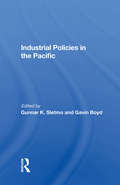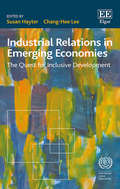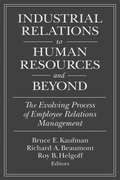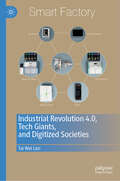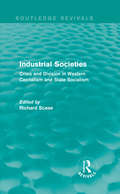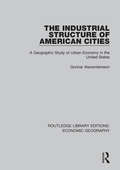- Table View
- List View
Industrial Location and Planning in the United Kingdom (Routledge Revivals)
by David KeebleFirst published in 1976, Industrial Location and Planning in the United Kingdom investigates in detail the nature of the changes taking place in the location of manufacturing industry since the 1950s and the reasons for them, including the effects of government regional policy and of factors such as market accessibility, labour availability and cost, transport facilities and personal residential preferences by industrialists and workers. The book brings together a wide range of published and unpublished material in discussing and evaluating explanations for regional and local manufacturing growth or decline. Government regional policy and planning is singled out for special attention, in terms of the impact of Development Area grants, of local planning controls, and of the town programmes. Manufacturing movement to new locations and the implications of government regional policies for industrial efficiency are examined in detail, together with the reasons for locational change in key but controversial industries such as steel, motor vehicles and electronics. This book will be of interest to students of urban planning, manufacturing, and development as well as city planners.
Industrial Location and Planning in the United Kingdom (Routledge Revivals)
by David KeebleFirst published in 1976, Industrial Location and Planning in the United Kingdom investigates in detail the nature of the changes taking place in the location of manufacturing industry since the 1950s and the reasons for them, including the effects of government regional policy and of factors such as market accessibility, labour availability and cost, transport facilities and personal residential preferences by industrialists and workers. The book brings together a wide range of published and unpublished material in discussing and evaluating explanations for regional and local manufacturing growth or decline. Government regional policy and planning is singled out for special attention, in terms of the impact of Development Area grants, of local planning controls, and of the town programmes. Manufacturing movement to new locations and the implications of government regional policies for industrial efficiency are examined in detail, together with the reasons for locational change in key but controversial industries such as steel, motor vehicles and electronics. This book will be of interest to students of urban planning, manufacturing, and development as well as city planners.
Industrial Policies In The Pacific
by Gunnar K. SletmoIn GATT negotiations over the past several years the United States, a founding member of the Asia Pacific Economic Cooperation Forum, has been pushing hard for a global liberalization of trade in services. This development would have special significance for the Pacific because of the intensifying competition between the United States and Japan for market shares. A comprehensive analysis of the service sector's role in that dynamic region is offered in this timely volume. Leading experts explore how service enterprises have affected trade in goods and transnational manufacturing, forming a regional pattern of interdependence. The authors assess each service sector from a regional perspective and offer detailed individual country studies as well. The concluding chapters provide a broad overview of corporate strategies, discuss questions of regional cooperation, and identify opportunities for new regional service enterprises.
Industrial Policies In The Pacific
by Gunnar K. Sletmo Gavin BoydIn GATT negotiations over the past several years the United States, a founding member of the Asia Pacific Economic Cooperation Forum, has been pushing hard for a global liberalization of trade in services. This development would have special significance for the Pacific because of the intensifying competition between the United States and Japan for market shares. A comprehensive analysis of the service sector's role in that dynamic region is offered in this timely volume. Leading experts explore how service enterprises have affected trade in goods and transnational manufacturing, forming a regional pattern of interdependence. The authors assess each service sector from a regional perspective and offer detailed individual country studies as well. The concluding chapters provide a broad overview of corporate strategies, discuss questions of regional cooperation, and identify opportunities for new regional service enterprises.
Industrial Policy in Europe after 1945: Wealth, Power and Economic Development in the Cold War
by Alexander Nützenadel Christian GrabasBringing together renowned scholars in the field with younger researchers, this interdisciplinary study of the history of post-war industrial policy in Europe investigates transfers across borders and locates industrial policy in the context of the Cold War from a global perspective.
Industrial Redundancies: A Comparative Analysis of the Chemical and Clothing Industries in the UK and Italy (Routledge Revivals)
by Lidia GrecoThis title was first published in 2002. This work explores processes of corporate restructuring and employment change in two industrial areas, Teeside (in the north-east of England) and Brindisi (in the south-east of Italy), by drawing upon evidence from two industries - the chemical and clothing sectors.
Industrial Redundancies: A Comparative Analysis of the Chemical and Clothing Industries in the UK and Italy (Routledge Revivals)
by Lidia GrecoThis title was first published in 2002. This work explores processes of corporate restructuring and employment change in two industrial areas, Teeside (in the north-east of England) and Brindisi (in the south-east of Italy), by drawing upon evidence from two industries - the chemical and clothing sectors.
Industrial Relations and European Integration: Trans and Supranational Developments and Prospects (Routledge Revivals Ser.)
by Hans-wolfgang Platzer Berndt KellerThis title was first published in 2003.The completion of the Single Market and the launching of the European Monetary Union during the 1990s have been accompanied by processes of socio-economic restructuring and major changes in the structure and forms of governance within the dynamic multi-level EU system. The patterns of reaction and adaptation of national industrial relations systems to these EU - developments are discussed under the heading of "Europeanisation" of national IR-systems. The Maastricht and Amsterdam Treaties have extended - to a certain degree - the scope for legislative and coordinated activities by the EU in the fields of social, labour - market and employment policies. These basic legal and political decisions have created new avenues for the development of transnational industrial relations and the establishment of new arenas for EU - level interaction, including social dialogues between the social partners. .
Industrial Relations and European Integration: Trans and Supranational Developments and Prospects (Routledge Revivals Ser.)
by Hans-wolfgang Platzer Berndt KellerThis title was first published in 2003.The completion of the Single Market and the launching of the European Monetary Union during the 1990s have been accompanied by processes of socio-economic restructuring and major changes in the structure and forms of governance within the dynamic multi-level EU system. The patterns of reaction and adaptation of national industrial relations systems to these EU - developments are discussed under the heading of "Europeanisation" of national IR-systems. The Maastricht and Amsterdam Treaties have extended - to a certain degree - the scope for legislative and coordinated activities by the EU in the fields of social, labour - market and employment policies. These basic legal and political decisions have created new avenues for the development of transnational industrial relations and the establishment of new arenas for EU - level interaction, including social dialogues between the social partners. .
Industrial Relations in Emerging Economies: The Quest for Inclusive Development
by Susan Hayter Chang-Hee LeeBy examining the evolution of industrial relations institutions in the emerging economies of Brazil, China, India, South Africa and Turkey, the authors in this book assess the contribution of these institutions to inclusive development. Industrial Relations in Emerging Economies uses real-world examples to assess the relevance of the conceptual frameworks used to examine employment relations. The chapters focus on the evolution of industrial relations institutions and the role that these have played in periods of economic and political transition. They demonstrate that rather than acting as a constraint on development, trade unions can contribute to stability, security and equity. The contribution of industrial relations institutions to inclusive development nonetheless remains the subject of debate, viewed by some as increasingly irrelevant to the vast numbers of workers in the informal economy. The authors here, however, reveal a continuing demand for independent collective interest representation in labour relations, whether in the informal economy or in rapidly industrializing districts. This book will prove an interesting and stimulating read for students, academics and researchers in the fields of human resources, industrial relations, sociology and labour economics in addition to trade union researchers and policy-makers.
Industrial Relations in the British Printing Industry: The Quest for Security (Routledge Revivals)
by John ChildFirst published in 1967, Industrial Relations in the British Printing Industry was written to provide a comprehensive picture of the development of organisations of both employers and those employed in the British printing industry. The book traces the story from the seventeenth century Craft Guilds and the Stationers Company, through the development of trade unions and union rule in the nineteenth century and up to the technical revolution of the early 1900s. Later chapters cover in detail problems such as restrictive practices and productivity bargaining in the thirty years prior to the original publication of the book. It also explores how their aims and strategies are related to changing technological and economic conditions. Industrial Relations in the British Printing Industry will appeal to those with an interest in social history and the history of industrial relations, particularly with regards to the printing industry.
Industrial Relations in the British Printing Industry: The Quest for Security (Routledge Revivals)
by John ChildFirst published in 1967, Industrial Relations in the British Printing Industry was written to provide a comprehensive picture of the development of organisations of both employers and those employed in the British printing industry. The book traces the story from the seventeenth century Craft Guilds and the Stationers Company, through the development of trade unions and union rule in the nineteenth century and up to the technical revolution of the early 1900s. Later chapters cover in detail problems such as restrictive practices and productivity bargaining in the thirty years prior to the original publication of the book. It also explores how their aims and strategies are related to changing technological and economic conditions. Industrial Relations in the British Printing Industry will appeal to those with an interest in social history and the history of industrial relations, particularly with regards to the printing industry.
Industrial Relations to Human Resources and Beyond: The Evolving Process of Employee Relations Management
by Bruce E. Kaufman Richard A. Beaumont Roy B. HelfgottThis collection examines the evolution of the philosophy and practice of human resource management (HRM) and industrial relations (IR) over the twentieth century. By combining history, contemporary practice, and future trends, these well-known experts present both scholarly and practitioner perspectives. Drawing on in-depth interviews and surveys with HRM executives at leading corporations, the contributors explore key trends and issues facing global companies in such areas as equal opportunity, compensation practices, and expatriation programs. The book also takes an in-depth look at one particular player in the story - Industrial Relations Counselors, Inc., the first non-profit research and consulting organization dedicated to improved HRM/IR practices - which was founded by John D. Rockefeller in 1926, and has played a central role in the development of key labor legislation including the Social Security Act.
Industrial Relations to Human Resources and Beyond: The Evolving Process of Employee Relations Management (Issues In Work And Human Resources Ser.)
by Bruce E. Kaufman Richard A. Beaumont Roy B. HelfgottThis collection examines the evolution of the philosophy and practice of human resource management (HRM) and industrial relations (IR) over the twentieth century. By combining history, contemporary practice, and future trends, these well-known experts present both scholarly and practitioner perspectives. Drawing on in-depth interviews and surveys with HRM executives at leading corporations, the contributors explore key trends and issues facing global companies in such areas as equal opportunity, compensation practices, and expatriation programs. The book also takes an in-depth look at one particular player in the story - Industrial Relations Counselors, Inc., the first non-profit research and consulting organization dedicated to improved HRM/IR practices - which was founded by John D. Rockefeller in 1926, and has played a central role in the development of key labor legislation including the Social Security Act.
Industrial Revolution 4.0, Tech Giants, and Digitized Societies
by Tai Wei LimIndustry 4.0 explores the emergence of disruptive digital technologies such as robotics, blockchain, nanotechnology and 3D printing and their impact on human lives and jobs in globalized 21st century societies. Incorporating a cutting edge area studies perspective, it considers the challenges and long term implications of the rise of ‘Tech Giants’ such as Alibaba, Google and Baidu through the lens of past industrial revolutions, looking back at the transformative technologies and industrial developments - the steam engine, electrification, telegraph, mass production, and the rise of digital technology - upon which the modern world was built. It investigates the mirror profiles of the world’s largest tech companies in the US and China (Baidu and Google, Alibaba and Amazon, Wechat and Facebook) and provides a unique comparison of Tech Giants with 19th century colonial empires and monopolistic trading companies in terms of political-economic dominance. A key tool for instructors and students focused on courses on Technological History, Digital Technology and Cultures, New Media, Digital Ethics and China studies, this book provides practical guidance on how readers can equip themselves to face key workplace and societal challenges in a virtually interconnected world shaped by Tech Giant monopoly.
The Industrial Revolution in World History
by Peter N. StearnsNow in its fifth edition, this book explores the ways in which the industrial revolution reshaped world history, covering the international factors that helped launch the industrial revolution, its global spread and its impact from the end of the eighteenth century to the present day. The single most important development in human history over the past three centuries, the industrial revolution continues to shape the contemporary world. Revised and brought into the present, this fifth edition of Peter N. Stearns’ The Industrial Revolution in World History extends his global analysis of the industrial revolution. Looking beyond the West, the book considers India, the Middle East and China and now includes more on key Latin American economies and Africa as well as the heightened tensions, since 2008, about the economic aspects of globalization and the decline of manufacturing in the West. This edition also features a new chapter on key historiographical debates, updated suggestions for further reading and boxed debate features that encourage the reader to consider diversity and different viewpoints in their own analysis, and pays increased attention to the environmental impacts. Illustrating the contemporary relevance of the industrial revolution's history, this is essential reading for students of world history and economics, as well as for those seeking to know more about the global implications of what is arguably the defining socioeconomic event of modern times.
The Industrial Revolution in World History
by Peter N. StearnsNow in its fifth edition, this book explores the ways in which the industrial revolution reshaped world history, covering the international factors that helped launch the industrial revolution, its global spread and its impact from the end of the eighteenth century to the present day. The single most important development in human history over the past three centuries, the industrial revolution continues to shape the contemporary world. Revised and brought into the present, this fifth edition of Peter N. Stearns’ The Industrial Revolution in World History extends his global analysis of the industrial revolution. Looking beyond the West, the book considers India, the Middle East and China and now includes more on key Latin American economies and Africa as well as the heightened tensions, since 2008, about the economic aspects of globalization and the decline of manufacturing in the West. This edition also features a new chapter on key historiographical debates, updated suggestions for further reading and boxed debate features that encourage the reader to consider diversity and different viewpoints in their own analysis, and pays increased attention to the environmental impacts. Illustrating the contemporary relevance of the industrial revolution's history, this is essential reading for students of world history and economics, as well as for those seeking to know more about the global implications of what is arguably the defining socioeconomic event of modern times.
Industrial Societies: Crisis and Division in Western Capatalism (Routledge Revivals)
by Richard ScaseThis book, first published in 1989, addresses an issue that stood at the centre of sociological concern – the changing character of industrial societies. The authors examine the nature of the industrialization process, in terms of its impact upon and development within both state socialist and capitalist societies. Is ‘industrialism’ a constant phenomenon within both kinds of society, or are distinctive differences apparent? In the 1960s, it did seem that economic growth and technological change were producing similarities in social structure between the different socio-political systems; it now appears however that the crisis that have developed during the 1980s how illustrated their contrasts. Through the analysis of this trend in the West, in Eastern Europe and in China the authors clarify central issues for the student of sociology: The changing character of national states, organized labour, stratification systems and class relationships Processes of social integration, cohesion and control The extent to which dominant groups are able to sustain social and economic privileges in different socio-economic systems The changing pattern of work and employment relationships The nature of class, gender and ethnicity as sources of socio-economic division
Industrial Societies: Crisis and Division in Western Capatalism (Routledge Revivals)
by Richard ScaseThis book, first published in 1989, addresses an issue that stood at the centre of sociological concern – the changing character of industrial societies. The authors examine the nature of the industrialization process, in terms of its impact upon and development within both state socialist and capitalist societies. Is ‘industrialism’ a constant phenomenon within both kinds of society, or are distinctive differences apparent? In the 1960s, it did seem that economic growth and technological change were producing similarities in social structure between the different socio-political systems; it now appears however that the crisis that have developed during the 1980s how illustrated their contrasts. Through the analysis of this trend in the West, in Eastern Europe and in China the authors clarify central issues for the student of sociology: The changing character of national states, organized labour, stratification systems and class relationships Processes of social integration, cohesion and control The extent to which dominant groups are able to sustain social and economic privileges in different socio-economic systems The changing pattern of work and employment relationships The nature of class, gender and ethnicity as sources of socio-economic division
Industrial Society: Class, Cleavage and Control (Routledge Revivals)
by Richard ScaseAny study of contemporary industrial societies must take into account the role of power, ideology and class, and the degree to which these determine the development of social structures. This book, first published in 1977 and based on a selection of eleven papers given at a conference of the British Sociological Association, focuses upon aspects of continuity and change in modern society, comparing and contrasting dimensions of class, cleavage and control in capitalist and socialist societies. This book is key reading for students of both sociology and business studies.
Industrial Society: Class, Cleavage and Control (Routledge Revivals)
by Richard ScaseAny study of contemporary industrial societies must take into account the role of power, ideology and class, and the degree to which these determine the development of social structures. This book, first published in 1977 and based on a selection of eleven papers given at a conference of the British Sociological Association, focuses upon aspects of continuity and change in modern society, comparing and contrasting dimensions of class, cleavage and control in capitalist and socialist societies. This book is key reading for students of both sociology and business studies.
The Industrial Structure of American Cities (Routledge Library Editions: Economic Geography)
by Gunnar AlexanderssonThis book analyzes the distribution of the urban population in an industrialized country. The USA was chosen as the object of the study because it had, at the time of writing, in 1956, the largest population for which homogeneous and comparable statistics were available. The first step in the quantitative analysis of population distribution, according to the method suggested here, is the breaking up of the total population into its components: the industries in which people earn their living. Extensive maps support the text as it discusses the problem of industrial location which has attracted much attention from geographers and economists.
The Industrial Structure of American Cities (Routledge Library Editions: Economic Geography)
by Gunnar AlexanderssonThis book analyzes the distribution of the urban population in an industrialized country. The USA was chosen as the object of the study because it had, at the time of writing, in 1956, the largest population for which homogeneous and comparable statistics were available. The first step in the quantitative analysis of population distribution, according to the method suggested here, is the breaking up of the total population into its components: the industries in which people earn their living. Extensive maps support the text as it discusses the problem of industrial location which has attracted much attention from geographers and economists.
Industrial Subsidies: The UK Experience
by C. WrenThis book describes the adoption, growth and subsequent relinquishment of industrial subsidies in the UK, tracing their development back to the early years of this century and following their extension through to virtually every area of economic policy. This includes the foothold gained for industrial subsidies in the run-up and aftermath of the First World War, the application of large-scale subsidies to agriculture in the Depression, the plans for an interventionist industrial strategy devised in the Second World War and the gradual expansion of industrial subsidies from this time through to their heyday in the late-1970s. Considerable attention is devoted to events in the 1980s, including the extension of financial assistance to urban and rural policy, small and new firm measures, technology support, collaborative research programmes and advisory schemes.
Industrial Teesside, Lives and Legacies: A post-industrial geography
by Jonathan WarrenThis book evaluates the consequences of economic, social, environmental and cultural change on people living and working within Teesside in the North-East of England. It assesses the lived experiences, working lives, health and cultural perspectives of residents and key stakeholders in the wake of serious de-industralisation in the region. The narrative is embedded within the long-term industrial history of Stockton: an area once dominated by steel, coal and chemical industries. This past still continues to shape its future and influences the ways in which that future is conceived and envisioned. The author explores a ‘biography of place’ analytical framework to offer a holistic view of the area, which considers the interaction between the social, economic, cultural, visual and environmental legacy of the community, which is firmly grounded in the past, present and future prospects of those who live and work there.

